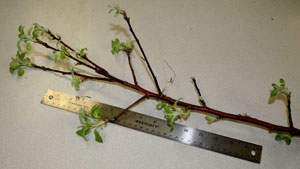by B. Edmunds, M. Small, C. Swift, and T. Blunt* (8/20)
Revised by S. Caffey**
Quick Facts…
- There are hundreds of plant diseases, insects and weeds that occur in Colorado.
- Good sample collecting and handling are necessary to obtain an accurate diagnosis of your plant’s problem
- Clinics are not open on weekends or holidays.
- Ship early in the week so samples don’t sit in the post office over the weekend.
- Its important to include as many details as possible for a better diagnosis.
Plant problems are common to every grower. There are hundreds of plant diseases, insects and weeds that occur in Colorado. Some plant problems are very common and easily recognized; others require more advanced laboratory techniques to identify. Most county Extension offices have staff trained in basic plant problem diagnostics. Samples can also be sent to trained specialists at a CSU Extension Plant Diagnostic Clinic located throughout the state.
Good sample collecting and handling are necessary to obtain an accurate diagnosis of your plant’s problem. Follow the steps below to properly collect, package and ship plant samples.
General Sample Collection Guidelines
- Collect a fresh sample. Diagnosis is difficult to impossible with dead or dried plants.
- Collect samples the same day you ship or drop off. Don’t leave samples in vehicles overnight. Intense heat or cold will destroy the sample.
- Whole plant samples, including the roots, are more desirable than individual leaves or branches whenever possible.
- Include soil with whole plant samples, if requested, so it can be tested for pH, salts and evaluated for textural issues.
- Keep soil off foliage by separately bagging root system.
- Provide a detailed history of the plant and site.
 |
| Turf Sample |
Turf
Golf course personnel should bring a cup cutter size piece of turf. Others, including professional turf managers, sports field managers and homeowners, should dig a 2-3 inch deep shoebox-sized rectangular sample showing transition from healthy to affected turf. Cover roots with aluminum foil to prevent soil from shaking loose and contaminating blades.
Trees and shrubs
 |
| Good branch sample. |
Collect a 12-24 inch long branch with leaves attached. Sample should show transition from healthy to affected foliage.
Weed/plant identification
A fresh sample (not dried) is usually required. Include as many plant parts as possible–entire plant, leaves, twigs, flowers, fruit and roots. A single leaf or grass blade is not sufficient.
Insect identification
Insect should not be squashed or dried. Place insects in vials or other rigid containers. Larvae should be placed in 70% alcohol.
How to ship samples
- Clinics are not open on weekends or holidays. Ship early in the week so samples don’t sit in the post office over the weekend. Use overnight services whenever possible.
- Wrap sample in dry paper towel and place in sealed plastic bag. Do not add any additional water.
- Wrap rootball/soil separately from plant. If not separately wrapped, movement and vibration during shipment can spread soil to foliage and contaminate it.
- Place wrapped sample in a box with crumpled newspaper or similar material to stabilize sample.
- Place your sample information in a separate bag. Moisture from the sample can disintegrate paper and cause ink to run.
Providing plant history/information
Each plant diagnostic clinic has a sample submission form. Go to the clinic’s website and download the form. It’s important to include as many details as possible for a better diagnosis.
Accompanying images
Photographs to supplement a physical sample can be very helpful in diagnosis. For example, if you are submitting a tree sample, take a photograph of the entire tree and another of the affected area. You can e-mail digital images, or put hard copies in with the sample. Care must be taken to place the prints in a separate ziplock-type plastic bag to ensure that they won’t get wet or otherwise damaged.
Colorado State University Extension Plant Diagnostic Clinic
CSU Spur campus:
This is the main diagnostic clinic for the state. It is located in Denver at the CSU Spur campus in the Terra Building.
Contact: Ana Cristina Fulladolsa
*B. Edmunds, former Colorado State University regional Extension specialist for commercial greenhouse and nurseries; M. Small, Jefferson County Extension urban integrated pest management agent; C. Swift, Tri River Area Extension horticulture agent; T. Blunt, Colorado State University Campus Plant Diagnostic Clinic plant diagnostician. **S. Caffey, Colorado State University Extension agent, horticulture, Pueblo County. 4/11. Revised 8/20.
Colorado State University, U.S. Department of Agriculture and Colorado counties cooperating. CSU Extension programs are available to all without discrimination. No endorsement of products mentioned is intended nor is criticism implied of products not mentioned.
Go to top of this page.





